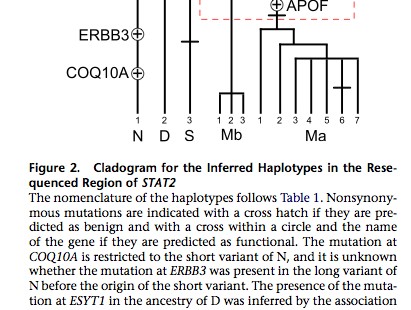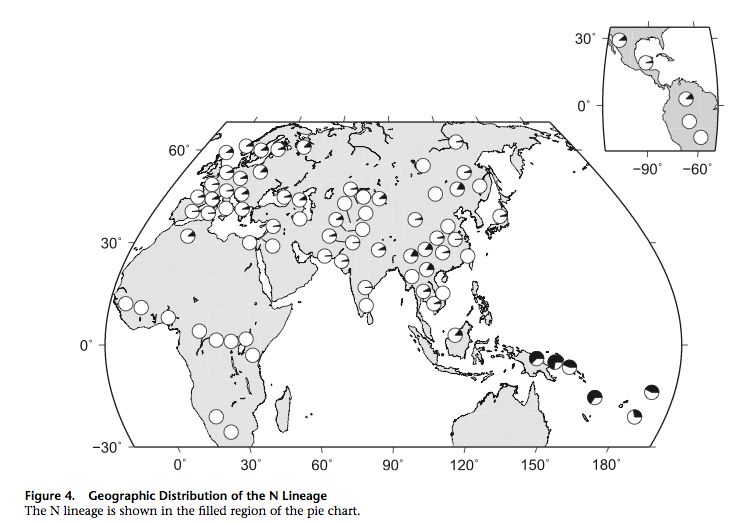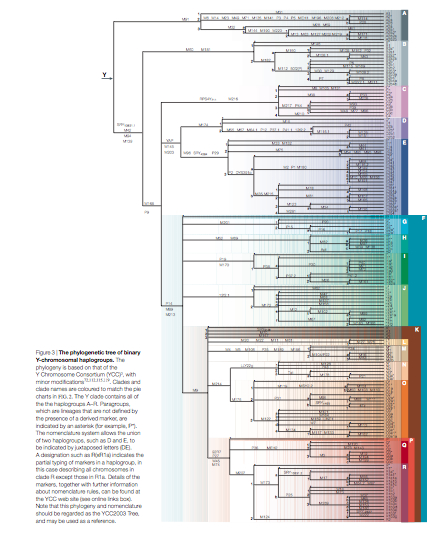
Archaic Introgression and the Derived Nature of African Lineages at STAT2 Gene
American Journal of Human Genetics 91, 2012, 265-274. http://dx.doi.org/10.1016/j.ajhg.2012.06.015.
A Haplotype at STAT2 Introgressed from Neanderthals and Serves as a Candidate of Positive Selection in Papua New Guinea
Fernando L. Mendez, Joseph C. Watkins, and Michael F. Hammer.
Signals of archaic admixture have been identified through comparisons of the draft Neanderthal and Denisova genomes with those of living humans. Studies of individual loci contributing to these genome-wide average signals are required for characterization of the introgression process and investigation of whether archaic variants conferred an adaptive advantage to the ancestors of contemporary human populations. However, no definitive case of adaptive introgression has yet been described. Here we provide a DNA sequence analysis of the innate immune gene STAT2 and show that a haplotype carried by many Eurasians (but not sub-Saharan Africans) has a sequence that closely matches that of the Neanderthal STAT2. This haplotype, referred to as N, was discovered through a resequencing survey of the entire coding region of STAT2 in a global sample of 90 individuals. Analyses of publicly available complete genome sequence data show that haplotype N shares a recent common ancestor with the Neanderthal sequence (~80 thousand years ago) and is found throughout Eurasia at an average frequency of ~5%. Interestingly, N is found in Melanesian populations at ~10-fold higher frequency (~54%) than in Eurasian populations. A neutrality test that controls for demography rejects the hypothesis that a variant of N rose to high frequency in Melanesia by genetic drift alone. Although we are not able to pinpoint the precise target of positive selection, we identify nonsynonymous mutations in ERBB3, ESYT1, and STAT2—all of which are part of the same 250 kb introgressive haplotype — as good candidates.
This paper builds a case for another genetic locus showing signs of “archaic admixture.” As different labs and genome bloggers are going back and forth on the issue of what those genetic similarities between (largely non-African) humans, on the one hand, and Neandertals and/or Denisovans, on the other hand, exactly mean – archaic admixture, ancient African population structure or both, it’s important to look into some of the other findings that the papers such as Mendez et al. (2012) bring along the way.
In Table 1 Mendez et al. (2012) list all the uncovered STAT2 haplotypes and their Old World distributions. (Although American Indian populations were included in the study as part of a bulk of previously published sequences, their sample was not specially resequenced for this study, unlike the core of the authors’ modern human sample that included Mandenka, Biaka Pygmy, San, Basque, Han, and Pauans.)
While the focus of the paper is on the introgressed haplotype N (note its nearly perfect match with the Neandertal sequence), Table 1 also shows the contrast between the distribution of Ma- and Mb-haplotypes. Ma-haplotypes are restricted to Africans, while Mb-haplotypes are mostly found outside of Africa, with the most common Mb-1 lineage also detected at low frequencies in Mbuti Pygmy and Mandenka.
The authors constructed a phylogeny of all the haplotypes – archaic and modern – and the phylogenetic relationship between Mb and Ma is made clear (see Fig. 2 on the  left). The most common African haplotype Ma is derived in relationship to Mb-haplotype, which is dominant in non-Africans. Non-Africans also show greater haplotype diversity in Mb compared to Africans, as they have two rare Mb2 and Mb3 types, while Africans only have the most common Mb1 type. (Not surprisingly, the openly biased in favor of out-of-Africa blog by Luis Aldamiz makes no mention of this fact and fails to publish the telling phylogenetic tree.)
left). The most common African haplotype Ma is derived in relationship to Mb-haplotype, which is dominant in non-Africans. Non-Africans also show greater haplotype diversity in Mb compared to Africans, as they have two rare Mb2 and Mb3 types, while Africans only have the most common Mb1 type. (Not surprisingly, the openly biased in favor of out-of-Africa blog by Luis Aldamiz makes no mention of this fact and fails to publish the telling phylogenetic tree.)
Haplotype S restricted to Namibian San is an outlier compared to both Ma and Mb. But Haplotype N detected only in non-Africans is an outlier compared to haplotype S. Hence, the distribution of the most divergent haplotypes replicates the distribution of the least divergent ones. If we did not have a draft of Neandertal genome, we would not have known that haplotype N may have introgressed into modern humans from Neandertals. We don’t have a reference sequence from an African archaic hominin, hence we cannot say whether haplotype S is a divergent human lineage of the product of African-specific introgression. The fact that haplotype S is restricted to Africa suggests that it may have introgressed into San from an archaic African hominin. Had it been a native modern human lineage, we would have encountered it outside of Africa, too, as it would have been carried out as part of the putative out-of-Africa expansion.
Considering that the bulk of African variation found at STAT2 is likely derived from outside of Africa, the evidence for an earlier out-of-Africa expansion, presumably associated with haplotype S, is non-existent because, again, haplotype S is African-specific.
Notably, Y-DNA provides the closest match to the observed derived status of the majority of African lineages. African hg E is a subset of the Eurasian clade CT (see below, from Jobling, Mark, and Chris Tyler-Smith. 2003. “The Human Y Chromosome: An Evolutionary Marker Comes of Age, ” Nature Reviews 4, 602).
If the similarity between the phylogenies of Y-DNA and STAT2 is indeed nonrandom, then it’s possible that the divergent but African-specific Y-DNA hgs A and B are products of archaic admixture in Africa. But it’s necessary to point out that so far no traces of Neandertal or Denisovan admixture have been detected on Y-DNAs or mtDNAs outside of Africa.
Mendez et al. (2012) also include a global map of the distribution of haplotype N of supposedly Neandertal origin. Thankfully, American Indian populations are included, which is rare in this kind of studies.
 American Indians follow the general Eurasian pattern of being polymorphic with respect to haplotype N, with some tribes deep in South America following the Sub-Saharan African pattern of not having haplotype N. Since, the paper does not discuss American Indian results, it’s unclear if the current pattern of variation has anything to do with European admixture in Amerindians, as was proposed in the case of MAPT inversion, presumably introgressed from Neandertals (see Donelly et al. 2010. “The Distribution and Most Recent Common Ancestor of the 17q21 Inversion in Humans,” Am J Hum Gen 86, 161-171). STAT2 haplotype N is not as frequent in Europeans as MAPT inversion, but still a discussion of European admixture in American Indians is always a worthy one to have.
American Indians follow the general Eurasian pattern of being polymorphic with respect to haplotype N, with some tribes deep in South America following the Sub-Saharan African pattern of not having haplotype N. Since, the paper does not discuss American Indian results, it’s unclear if the current pattern of variation has anything to do with European admixture in Amerindians, as was proposed in the case of MAPT inversion, presumably introgressed from Neandertals (see Donelly et al. 2010. “The Distribution and Most Recent Common Ancestor of the 17q21 Inversion in Humans,” Am J Hum Gen 86, 161-171). STAT2 haplotype N is not as frequent in Europeans as MAPT inversion, but still a discussion of European admixture in American Indians is always a worthy one to have.
The surprising finding of Mendez et al. (2012) is the 10-fold increase in the frequencies of haplotype N in Papuans, which they attribute to positive selection. Meanwhile, as the authors note, the high frequencies of introgressed archaic lineages in Papuans are further found in STAT2 haplotype D, which matches the Denisova sequence, as well as at OAS1 locus and in genome-wide surveys. They err, however, in describing the Denisova signal as “limited to Melanesia and a few neighboring island southeast Asian populations” because South American Indians show higher frequencies of Denisova alleles than Southeast Asians.



